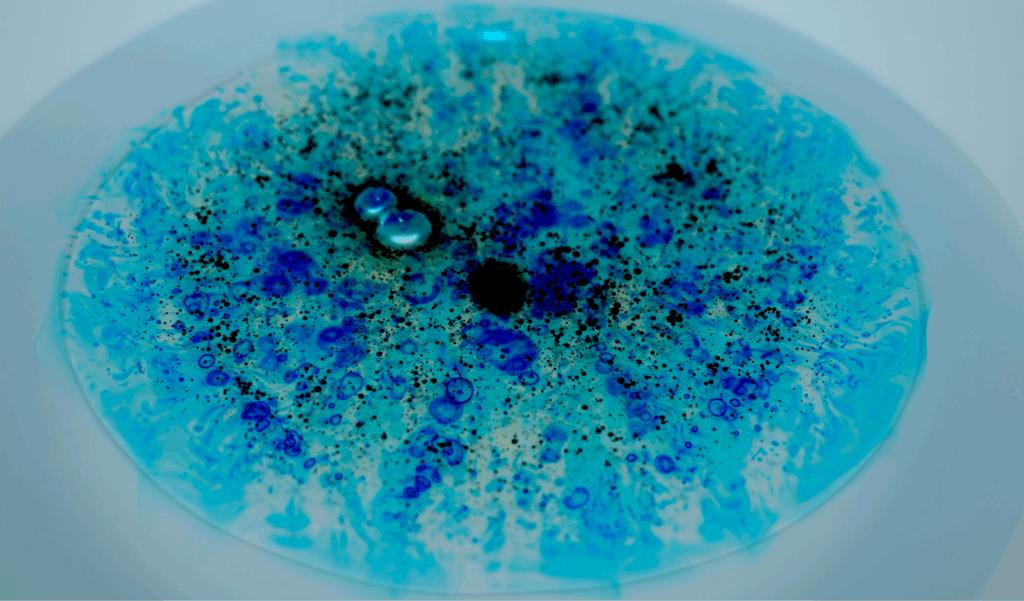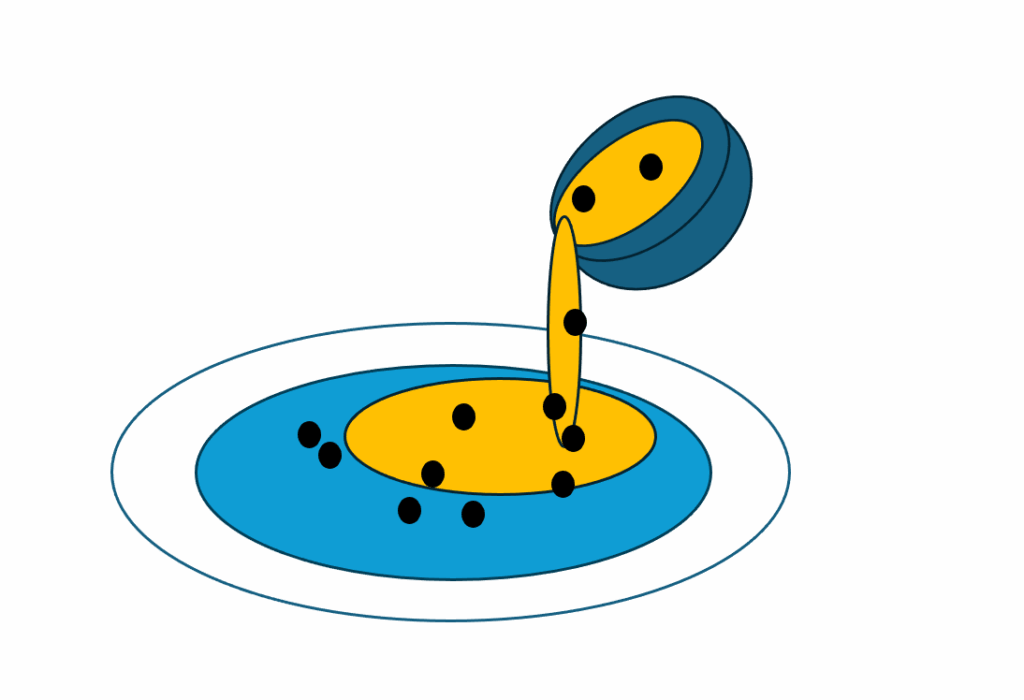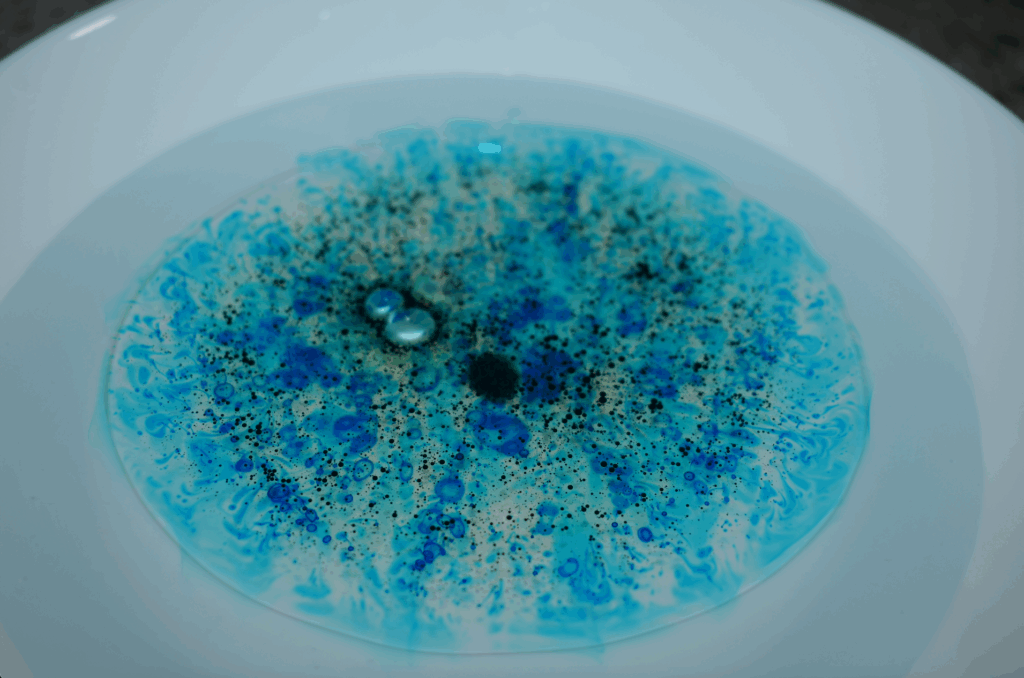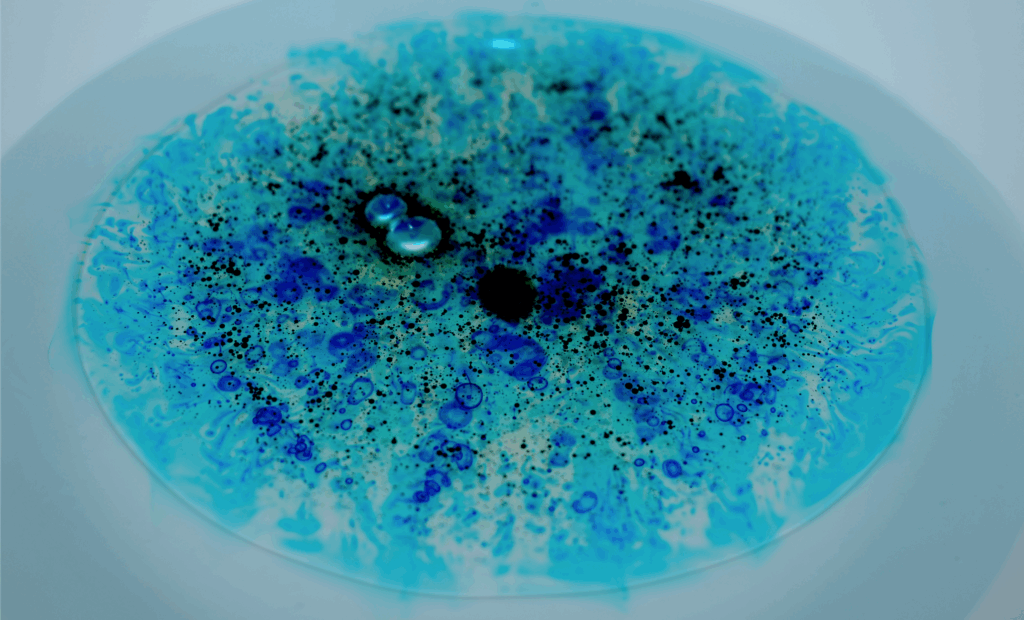The image captures a mixture of water with oil droplets containing food dye. As the dye diffuses from the oil into the water, a blooming effect is seen that reveals interactions between oil and water.
Diffusion of Food Coloring Through Olive Oil into Water

Cooper Wyrick
Get Wet
MCEN 4151-001
September 16th, 2025
This image was created as part of the “Get Wet” assignment in which fluid phenomena were explored through photography. For my submission, I focused on the interaction between food coloring, oil, and water. I began by mixing food coloring into olive oil with a fork in a small container, and then carefully poured the mixture into a shallow bowl of water. The resulting image captures the gradients of color as the food coloring diffuses from the oil into the surrounding water. The intent of this experiment was to observe and document a flow process that was scientifically interesting and visually engaging. While initial approaches did not produce clear visual patterns, the final image revealed diffusion effects that made the assignment, designed to “get our feet wet” in flow visualization, informative and artistic.
The flow apparatus in this experiment consisted of a shallow white bowl approximately 15 cm in diameter and 3 cm deep, filled with tap water. A small container was used to mix 5 drops of food coloring into 15 mL of olive oil with a fork, creating a suspension of small droplets. The oil-dye mixture was then slowly poured into the water from two inches above the water’s surface. The camera was positioned approximately 12 cm (5 inches) above the surface. The image produced was taken 10 seconds after the oil-dye mixture was poured into the water. The schematic diagram below shows the setup.

Figure 1: Schematic of Setup
The flow phenomenon of interest is the diffusion of food coloring into the polar water molecules through the medium of nonpolar olive oil molecules (Arnett 2024). Food coloring is water-soluble but not oil-soluble, so when mixed into olive oil it tends to form droplets and interfaces rather than dissolving. Once poured into water, the dye moves from high concentration to low concentration out of the oil into the aqueous surroundings, producing visible gradients and streaks. This process involves molecular diffusion across the oil-water interface and buoyancy-driven flow as the denser droplets of dye move downward under gravity while lighter oil tends to remain at the surface.
To characterize the flow, we consider the forces acting on the system. Gravity drives denser dye-water mixtures downward, while interfacial tension at the oil-water boundary opposes mixing. Because the motion of the droplets of dye is slow after being poured into the water, the estimated characteristic velocity is U = 1 × 10^-2 m/s based on visual observation. Taking a droplet diameter of D = 5 × 10^-3 m and using the kinematic viscosity of water at room temperature ν = 1.004 × 10⁻⁶ m²/s (Engineeringtoolbox 2025), we can calculate the Reynolds number.
Re = UD/v = (1 x 10-2(m/s) * 5 x 10-3(m))/1.004 x 10-6(m2/s) = 49.8007
Equation 1: Reynold’s Number of the Flow
This Reynolds number of about 50 indicates the flow is laminar. This is consistent with the observed smooth ringlets of dye spreading into the water rather than chaotic turbulence.
Diffusion was also a mechanism observed. For small water molecules, the molecular diffusivity is about Dm ≈ 1 × 10⁻⁹ m²/s (Dietrich). A ratio between advection and diffusion can be analyzed using the Peclet number equation (“The Peclet Number”). L, characteristic length, is the diameter of the food dye droplet in this scenario.
Pe = DL/Dm = (1 x 10-2(m/s) * 5 x 10-3(m))/ 1 x 10-9(m2/s) = 50,000
Equation 2: Peclet Number of the Flow
Since this is a very high Peclet number, advection is the primary form of transportation in the system rather than molecular diffusion because water and oil do not mix easily. However, at the oil-water interface, diffusion is responsible for the transfer of dye into water.
The combination of low Reynolds number and high Peclet number suggests that the shape of the dye plumes is determined by slow advection while the color gradients blur due to diffusion as the dye moves from areas of high concentration to low concentration. This explains the circular streams of food coloring that spread out into broader zones of color. Because olive oil (ρ = 0.92 g/cm^3) is less dense than water (ρ = 1 g/cm^3) at room temperature, the upward persistence of the oil at the interface due to buoyant forces also limits mixing, forcing the dye to pass through interfacial boundaries.
Visualizing the diffusion of the dye from the oil to the water required several components. The mixed liquids included tap water, extra virgin olive oil from 365, and food dye from 365. The handling tools included a small container and a shallow white plate. The temperature of the room at the time of this experiment was 70 degrees Fahrenheit. An indoor fluorescent light was used for the lighting during this experiment. The camera did not have a flash on. This was to emit glare from the water.
The photo was taken with the camera at an angle of 45 degrees below the horizontal. The field view was slightly larger than the diameter of the plate, coming to about 20 cm. The camera was positioned 12 cm above and 5 cm out from the phenomenon. The lens focal length was 30 mm. The camera used was a Nikon D3400, a digital single-lens reflex camera. The original image’s dimensions were 6000 × 4000 pixels. The final edited image was 5384 × 3312 pixels. The shutter speed was 1/100. The aperture was F 3.5. The ISO setting was 1400. The image processing involved cropping and increasing the contrast of the original image using the Gimp application. The original image is shown below.

Figure 2: Original Image of Phenomenon
The image reveals the interaction between oil and water, with plumes formed as food coloring diffuses through the oil into the water. I like that the photo captures the phenomenon in detail, though I dislike that part of the plate is out of focus. The fluid physics are demonstrated clearly, as the oil remains at the surface while the dye displays a concentration gradient in the water. One question I have is how the outcome would differ if different oil-dye mixing methods were used. Overall, I fulfilled my intent by capturing a scientifically and artistically engaging flow phenomenon. If I were to improve the work, I would enhance the focus quality of the image, and for future development, I would experiment with liquids other than water to observe whether and how diffusion occurs with different fluids.
Appendix
Arnett, Megan. “Mix It up with Oil and Water.” Scientific American, Scientific American, 20 Feb. 2024, www.scientificamerican.com/article/mix-it-up-with-oil-and-water/#:~:text=Oils%2C%20by%20contrast%2C%20are%20nonpolar,this%20property%20in%20this%20activity!
Dietrich, Olaf. “Diffusion Coefficients of Water.” Diffusion Coefficients of Water, dtrx.de/od/diff/#:~:text=Table_title:%2520Data%2520Table_content:%2520header:%2520%257C%2520Temperature%2520%257C,:%2520303.15%2520K%2520%257C%2520D/(%CE%BCm2/ms):%25202.597%2520%257C. Accessed 16 Sept. 2025.
Engineeringtoolbox, Editor. “Water – Dynamic and Kinematic Viscosity at Various Temperatures and Pressures.” Engineering ToolBox, 17 Mar. 2025, www.engineeringtoolbox.com/water-dynamic-kinematic-viscosity-d_596.html.
“The Peclet Number and How It Describes Fluid Transport.” Interface Fluidics, www.interfacefluidics.com/peclet-number-fluid-transport/. Accessed 16 Sept. 2025.


4 Comments. Leave new
I really liked the colors in this image. It was interesting to see the diffusion from the high concentration rings that developed.
Good job Cooper! You mentioned concerns about the rear portion of the plate being out of focus, but I still think that the image looks great as is. If you try taking the photo form above, it could be easier to focus on the entire pool of fluid.
I like the contrast of colors between the light blue and the dark blue.
I really like the rings that the dye formed under the surface, perhaps formed by the dye separating from the oil.